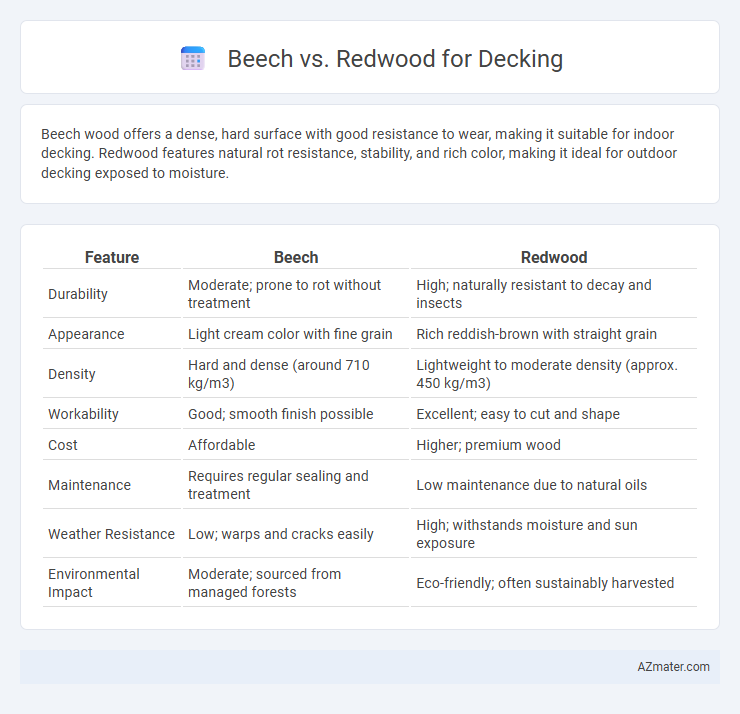Beech wood offers a dense, hard surface with good resistance to wear, making it suitable for indoor decking. Redwood features natural rot resistance, stability, and rich color, making it ideal for outdoor decking exposed to moisture.
Table of Comparison
| Feature | Beech | Redwood |
|---|---|---|
| Durability | Moderate; prone to rot without treatment | High; naturally resistant to decay and insects |
| Appearance | Light cream color with fine grain | Rich reddish-brown with straight grain |
| Density | Hard and dense (around 710 kg/m3) | Lightweight to moderate density (approx. 450 kg/m3) |
| Workability | Good; smooth finish possible | Excellent; easy to cut and shape |
| Cost | Affordable | Higher; premium wood |
| Maintenance | Requires regular sealing and treatment | Low maintenance due to natural oils |
| Weather Resistance | Low; warps and cracks easily | High; withstands moisture and sun exposure |
| Environmental Impact | Moderate; sourced from managed forests | Eco-friendly; often sustainably harvested |
Introduction to Beech and Redwood Decking
Beech decking offers a smooth texture and pale color, providing a contemporary look while being moderately durable for outdoor use. Redwood decking, prized for its rich reddish hues and natural resistance to decay and insects, stands out as a premium choice for longevity and aesthetic appeal. Both woods require proper sealing to maintain their appearance and structural integrity in outdoor environments.
Beech Wood Overview: Properties and Characteristics
Beech wood is a durable hardwood known for its fine, tight grain and pale cream color that often develops a warm reddish hue over time. It offers excellent strength and shock resistance, making it suitable for decking that requires stability under foot traffic. Beech also has good bending properties and moderate resistance to wear, although it is less naturally resistant to moisture and decay compared to redwood, necessitating proper sealing for outdoor use.
Redwood Overview: Properties and Advantages
Redwood is renowned for its natural resistance to decay, insects, and moisture, making it an ideal choice for outdoor decking applications. Its rich reddish hue and fine, straight grain provide aesthetic appeal alongside durability, reducing the need for frequent maintenance. The wood's stability and resistance to warping contribute to long-lasting, sturdy decks that withstand various weather conditions.
Durability Comparison: Beech vs Redwood
Redwood offers superior durability for decking due to its natural resistance to decay, moisture, and insect damage compared to Beech, which is a hardwood but less resistant to outdoor elements. Beech tends to absorb moisture easily, making it prone to warping, swelling, and rot when exposed to prolonged weather conditions. Redwood's dense cellular structure and natural tannins extend its lifespan and reduce maintenance, making it more suitable for long-lasting decks in varying climates.
Weather Resistance: Which Wood Performs Better?
Redwood outperforms beech in weather resistance for decking due to its natural oils and tight grain, which provide excellent resistance to moisture, decay, and insect damage. Beech is more prone to warping, swelling, and rot when exposed to outdoor elements over time, making it less durable for outdoor decking applications. Choosing redwood ensures a longer lifespan and lower maintenance needs in varying weather conditions.
Maintenance Requirements for Beech and Redwood Decks
Beech decks require frequent sealing and regular sanding to prevent moisture absorption and warping due to their porous nature, whereas redwood decks benefit from natural resistance to decay, needing occasional cleaning and resealing every two to three years. Beech wood's susceptibility to rot and insect damage demands consistent maintenance to preserve structural integrity and appearance. Redwood's inherent stability and natural oils reduce maintenance frequency, making it a lower-maintenance option for outdoor decking.
Aesthetic Appeal: Color and Grain Differences
Beech decking showcases a pale, creamy color with fine, uniform grain patterns that create a sleek and modern appearance, ideal for minimalist outdoor designs. Redwood features rich, warm reddish hues and distinctive, straight grain with occasional knots, offering a classic and rustic aesthetic that deepens with age and exposure. Choosing between beech and redwood for decking depends on desired visual impact: beech delivers subtle elegance, while redwood provides bold natural warmth.
Environmental Impact and Sustainability
Beech and redwood differ significantly in environmental impact and sustainability for decking; beech is often sourced from temperate hardwood forests with slower growth, leading to higher environmental costs per board foot, while redwood, especially from well-managed forests in the Pacific Northwest, offers faster renewability and carbon sequestration benefits. Redwood decking typically has a longer lifespan and natural resistance to decay, reducing replacement frequency and resource use, whereas beech lacks inherent rot resistance, often requiring chemical treatment that can affect ecological health. Selecting FSC-certified redwood ensures responsible forest management and supports sustainable practices, making it a more eco-friendly choice for decking compared to beech.
Cost Analysis: Beech vs Redwood Decking
Beech decking typically costs between $4 to $7 per square foot, offering a more budget-friendly option compared to redwood, which ranges from $6 to $10 per square foot due to its natural resistance to decay and insects. While redwood's higher price reflects its premium durability and aesthetic appeal, beech requires regular maintenance and treatments to enhance longevity, potentially increasing overall expenses. Considering both upfront costs and long-term maintenance is crucial for an accurate cost analysis when choosing between beech and redwood for decking projects.
Choosing the Right Wood for Your Decking Project
Beech offers a smooth texture and moderate durability but requires proper sealing to resist moisture and decay, making it suitable for covered or low-exposure decks. Redwood provides superior natural resistance to rot, insects, and weather, with a rich color that ages gracefully, ideal for outdoor decking with high exposure. Selecting the right wood depends on balancing budget, climate conditions, and desired maintenance levels to ensure long-lasting beauty and functionality in your decking project.

Infographic: Beech vs Redwood for Decking
 azmater.com
azmater.com